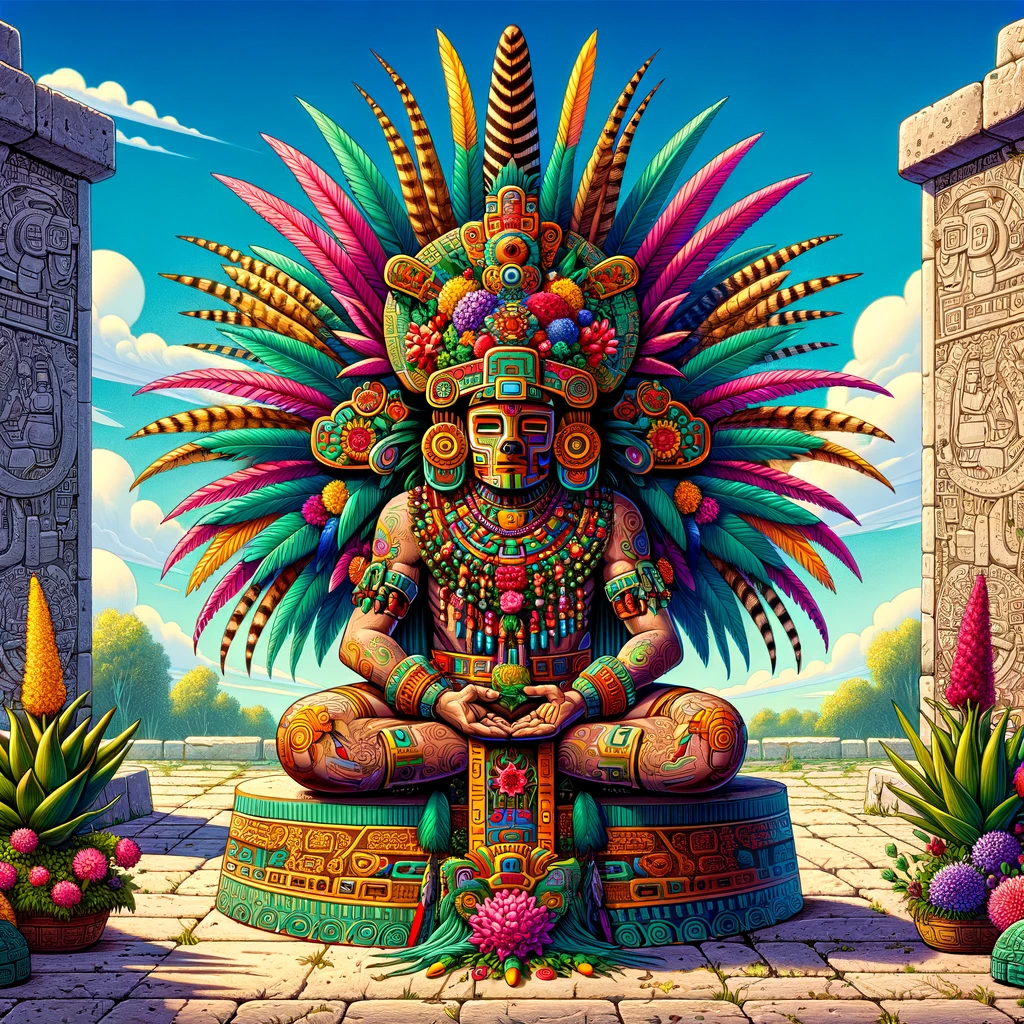
In the pantheon of Aztec mythology, Xochipilli stands out as a deity of multifaceted significance, embodying the exuberance of artistic expression, the joy of games, the allure of beauty, and the rhythm of dance. His name, derived from the Nahuatl language, translates to "Flower Prince," a title that encapsulates his connection to the blossoming of plants, particularly those with psychoactive properties.
Historical Context and Symbolism
The Aztecs, a Mesoamerican culture that flourished in central Mexico from the 14th to the 16th century, revered a complex pantheon of gods. Xochipilli, as a youthful and vibrant deity, was particularly associated with the arts, games, beauty, dance, flowers, maize, and love. He was often depicted adorned with colorful flowers, his face radiating joy and youthfulness. This depiction not only highlighted his domain over flowers and plants but also symbolized the vibrancy and ephemeral nature of life itself.
Connection to Agriculture and Psychoactive Plants
Xochipilli's connection to agriculture, specifically maize, the staple crop of the Aztecs, signifies his importance in ensuring a bountiful harvest. However, his association extends beyond mere cultivation to encompass the psychoactive plants used in religious and ceremonial contexts. This aspect underscores the Aztec understanding of the divine connection between the mind-altering properties of certain plants and the spiritual world.
Patron of Artists and Festivities
As the patron deity of artists, Xochipilli was central to Aztec cultural life. He was believed to inspire creativity in poets, musicians, painters, and dancers. Celebrations in his honor would be filled with artistic performances, showcasing the diverse talents blessed by the Flower Prince. His influence was not limited to professional artists; he was also a deity of play and games, emphasizing the importance of leisure and joy in Aztec society.
Xochipilli in Rituals and Ceremonies
Xochipilli was honored in various rituals and ceremonies, often involving music, dance, and the use of psychoactive plants. These rituals were not just celebrations but also means of connecting with the divine, seeking guidance, and expressing gratitude. The Aztecs believed that through these practices, they could communicate with Xochipilli and other deities, ensuring harmony and balance in their world.
Legacy and Modern Relevance
The legacy of Xochipilli extends beyond the historical confines of the Aztec empire. Today, he is often referenced in discussions about the use of psychoactive plants in traditional cultures. His figure has also become a symbol for the artistic and joyful aspects of life, inspiring modern artists and musicians who seek a connection with the ancient roots of creativity.
In conclusion, Xochipilli's multifaceted nature as the Aztec deity of art, games, beauty, and dance offers a fascinating glimpse into the rich tapestry of Aztec mythology and cultural values. His enduring legacy reminds us of the intrinsic human desire for creativity, joy, and connection with the natural world. As we continue to explore ancient cultures, figures like Xochipilli provide invaluable insights into the complexities of human spirituality and artistic expression.
Historical Context and Symbolism
The Aztecs, a Mesoamerican culture that flourished in central Mexico from the 14th to the 16th century, revered a complex pantheon of gods. Xochipilli, as a youthful and vibrant deity, was particularly associated with the arts, games, beauty, dance, flowers, maize, and love. He was often depicted adorned with colorful flowers, his face radiating joy and youthfulness. This depiction not only highlighted his domain over flowers and plants but also symbolized the vibrancy and ephemeral nature of life itself.
Connection to Agriculture and Psychoactive Plants
Xochipilli's connection to agriculture, specifically maize, the staple crop of the Aztecs, signifies his importance in ensuring a bountiful harvest. However, his association extends beyond mere cultivation to encompass the psychoactive plants used in religious and ceremonial contexts. This aspect underscores the Aztec understanding of the divine connection between the mind-altering properties of certain plants and the spiritual world.
Patron of Artists and Festivities
As the patron deity of artists, Xochipilli was central to Aztec cultural life. He was believed to inspire creativity in poets, musicians, painters, and dancers. Celebrations in his honor would be filled with artistic performances, showcasing the diverse talents blessed by the Flower Prince. His influence was not limited to professional artists; he was also a deity of play and games, emphasizing the importance of leisure and joy in Aztec society.
Xochipilli in Rituals and Ceremonies
Xochipilli was honored in various rituals and ceremonies, often involving music, dance, and the use of psychoactive plants. These rituals were not just celebrations but also means of connecting with the divine, seeking guidance, and expressing gratitude. The Aztecs believed that through these practices, they could communicate with Xochipilli and other deities, ensuring harmony and balance in their world.
Legacy and Modern Relevance
The legacy of Xochipilli extends beyond the historical confines of the Aztec empire. Today, he is often referenced in discussions about the use of psychoactive plants in traditional cultures. His figure has also become a symbol for the artistic and joyful aspects of life, inspiring modern artists and musicians who seek a connection with the ancient roots of creativity.
In conclusion, Xochipilli's multifaceted nature as the Aztec deity of art, games, beauty, and dance offers a fascinating glimpse into the rich tapestry of Aztec mythology and cultural values. His enduring legacy reminds us of the intrinsic human desire for creativity, joy, and connection with the natural world. As we continue to explore ancient cultures, figures like Xochipilli provide invaluable insights into the complexities of human spirituality and artistic expression.